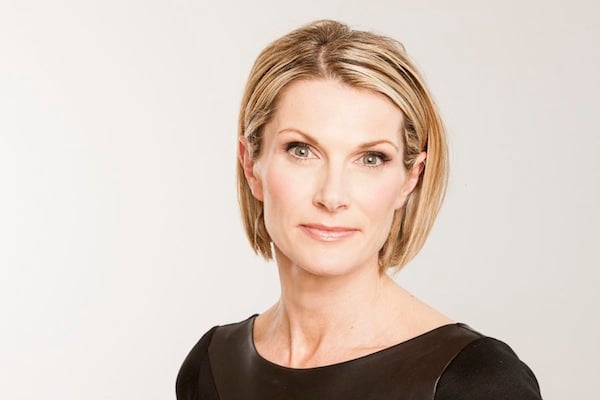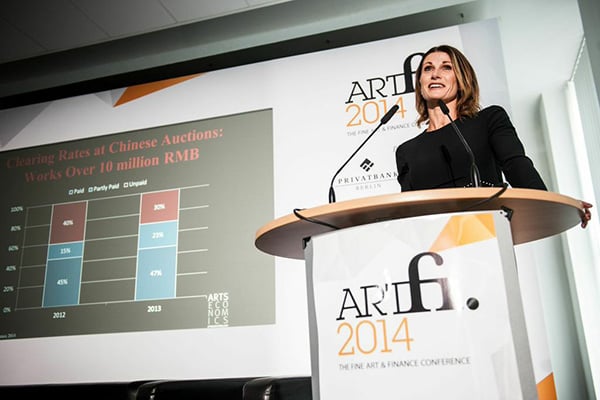Art Fairs
Clare McAndrew Explains How She Prepares the TEFAF Art Market Report
In advance of TEFAF 2015, the cultural economist talks data and trends.

www.paulmccarthyphotography.com.
In advance of TEFAF 2015, the cultural economist talks data and trends.

Cornell DeWitt

Every year, the art world eagerly awaits your annual market report, commissioned by TEFAF and released a few days before the fair opens to the public. How many years have you been doing the report? How did it come about?
The first report I did for TEFAF was in 2008 (although I had done some consulting work on one back in 2001), and I have been doing them annually since. They approached me to do it in 2007, which was just shortly after I had formally established my own company, Arts Economics. There were, and still are, very few independent economic research firms that specialize in the art market. It has been a great partnership, as we agree on the subject matter at the start of the year and then the research I do is completely independent and objective, which is important to me and also to the TEFAF Foundation.
Each year, in addition to the overall market analysis, you also pick a sector to dig into a little bit more in depth. Last year, it was digging deeper into the US and Chinese markets. What can you tell us about your focus this year?
This year apart from looking at fine art, we looked at some decorative art segments: 20th/21st-century design and Chinese decorative arts. Apart from looking at sales values, sectors, and what people are buying, this year we looked at how people are buying art and antiques and how that has changed. The big trends here are obviously fairs and the online market and we delve into these two areas in the report.
Each year, there is also something of a surprise that you dig up or come across in your research. Last year, people were surprised about the wobbliness in the Chinese market. Anything interesting we can look forward to this year?
One of the most interesting areas for me to look at was the online market. There has been a lot written about it already, so we tried to add something new to the research. For me, it involved really changing how I perceived the structure of the market. I had to stop thinking about it in the traditional sense of galleries, auction houses, and collectors and consider all of the various parties to all of the different transactions taking place. The online space has added whole new layers of intermediaries to transactions, some of which are intermediaries to intermediaries in the offline market. There is a limit to the increase in sales this generates, but it has certainly made the market easier to access.
The development of the online art space is very much themed towards the democratization of art, bridging the gap between the elite world of top collectors and the general public, and making art more accessible. However, many of the highest-spending top collectors of art do not need any alternatives to the top auction houses and galleries so online sales at the high end are still very small. For art buyers below the highest levels, the online art space certainly makes art more accessible.

Clare McAndrew speaking at the ArtFi conference in Berlin.
Photo: Courtesy ArtFi.
There are some really interesting innovations also happening in this space outside e-commerce, which focus on the way we consume and store art. I was introduced to several new ideas in this area with the consultant I worked with on this chapter (Andrew Klug). It will be really interesting to see how these all develop, as they are real innovations, rather than simply taking offline sales online.
Last year, you also showed that the much recently discussed “fairtigue” was actually beginning to show in the data. Are we going to see more of that?
Quite the opposite—fairs are doing very well. They are a drain on dealers in terms of cost and time but in terms of sales and visitors, they are very strong.
Last year, you were also quite bullish on the online art market. In light of shake-ups (Auctionata up, Artspace down) and rumored shake-ups (Paddle8 for sale? Artsy struggling?) and other issues in that arena (see The Truth About the Murky Online Art Market), are you going to stick with that?
See above (“The online space has added whole new layers of intermediaries to transactions, some of which are intermediaries to intermediaries in the offline market”).
Tell us a bit about how people respond to your reports. Have you seen instances of it moving markets? Are people upset, happy, thanking you, cursing you?
A lot of people do get the importance of generating some benchmark data on the market, measuring its economic impact and trying to take a measure of its size and key trends. I am pretty conservative in reporting on sales in the market, and some people have offered very different opinions on what size the market is and other aspects of it. But I have to base the reports on the objective information I can gather, rather than what people’s opinions are, especially as these are so varied.
I get a lot of comments about the data in China—even suggestions saying I should omit China from the report. I try to explain the issues as clearly as possible in the reports, and, again, the most important thing is to be unbiased and consistent in reporting data.
Can you tell us a bit about your process, tools, and methodologies—in layman’s terms, please!
We have to use a very mixed methodological approach as there is obviously no one source of data. It relies heavily on auction data, trade data, and surveys. Our methodology is very straightforward, but long. If you’re very actually interested, it’s in the appendix to the report.
The art market is notoriously opaque. Additionally, there are growing calls (mostly from outside the art world) for more regulation in the market (it should always be noted in these conversations that the art market—like any other commercial market—is plenty regulated under typical Uniform Commercial Code regulations and laws). Transparency in market dealings and data—like that championed by yourself and artnet—can work as a de facto form of regulation. Do you see this as a viable alternative? More to the point, do you see the art market being willing to embrace more transparency, as a potential path towards avoiding more regulation? (See 10 Things You Need to Know About Investing in Art.)
As you say, I think these views were from outside the art market, and perhaps not so well clued in to the reality of the current marketplace. The market in the US and Europe is already well regulated and there are many commercial codes protecting buyers, as well as anti-money laundering regulations, trade regulations, and others. It’s arguable that the market in Europe is in fact overregulated, and some Directives from Europe have potentially discouraged and displaced sales without great net benefits. China’s market is perhaps less well regulated, although this is also slowly changing.
The market took a huge leap forward for transparency with the development of art price databases such as Artnet’s. I worry it has moved a few steps back more recently, especially with online companies not publishing sales results and much more private selling. I think it’s hugely important for the market to be as transparent as is feasible. Although some in the art trade complain that it is detrimental to their businesses, those that are adding value can always justify prices and margins, so transparency is ultimately the best long-term strategy to encourage buyers and sales.
Arts Economics was founded by Dr. Clare McAndrew in 2005. Dr. McAndrew is a cultural economist who specializes in the arts, antiques, and collectibles markets. She set up Arts Economics to focus her efforts on art market research and analysis, and works with an international network of private consultants and academic researchers in providing research and consulting services to the global art trade and financial sector.
For more artnet News coverage about TEFAF 2015, see